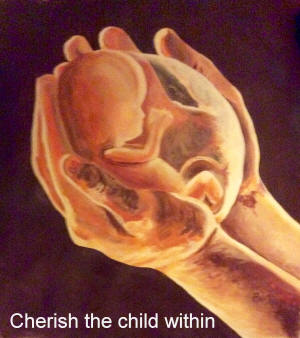Catholic Medical Quarterly Volume 66(2) May 2016
Editorial: Expressing the Beauty and Sanctity of Human Life
Dr. Adrian Treloar
 On page 19 of this journal we report a debate at the University College
London on conscientious objection and its importance to medicine. I was
invited as the CMA spokesperson. Reflecting on this debate afterwards, I
felt (as I almost always do) deeply shocked and traumatised by sitting for
two hours in a room where I was repeatedly told that abortion is a good
thing and that the unborn child is neither human nor deserving of respect.
The reality that abortion involves killing a human was simply not
recognised by those on the other side of the debate. For its proponents,
abortion is seen as good, and the killing of unborn children is seen as a
neutral act, or worse still, killing is simply seen as good. The most
vociferous pro-abortion campaigners simply reject the humanity and beauty
of the unborn child. That denial of humanity seems to me to be truly
shocking and sad. We must hold up the unborn child for the person whom we
know they are:- the very person whom many mothers will fall so in love
with immediately they know they are pregnant (or before!)
On page 19 of this journal we report a debate at the University College
London on conscientious objection and its importance to medicine. I was
invited as the CMA spokesperson. Reflecting on this debate afterwards, I
felt (as I almost always do) deeply shocked and traumatised by sitting for
two hours in a room where I was repeatedly told that abortion is a good
thing and that the unborn child is neither human nor deserving of respect.
The reality that abortion involves killing a human was simply not
recognised by those on the other side of the debate. For its proponents,
abortion is seen as good, and the killing of unborn children is seen as a
neutral act, or worse still, killing is simply seen as good. The most
vociferous pro-abortion campaigners simply reject the humanity and beauty
of the unborn child. That denial of humanity seems to me to be truly
shocking and sad. We must hold up the unborn child for the person whom we
know they are:- the very person whom many mothers will fall so in love
with immediately they know they are pregnant (or before!)
The other insight that I gained was the willingness of pro-abortion campaigners to allow conscientious objection. By doing so they see the opportunity to ensure that women in early pregnancy only see doctors and nurses who are pro-abortion and who may well encourage women along that path. In other words, the pro-abortion campaigners aim is to create a world where people who value life cannot counsel or support those who value life. That is surely wrong. It merely helps to guarantee the outcome that the child within, healthy and beautifully nurtured in its mother womb, is killed with no fuss, and hidden as far as possible from the public eye.
What can we do about this?
First, we must ensure that those who respect the beauty and sanctity of unborn human life can continue to provide advice to women who seek abortion at a time of crisis in their life. While we must do that sensitively and well, it is simply not good enough for society to deprive women of the opportunity to hear a different view.
Having said that, we must also be completely aware that the arguments against abortion are not to be hammered out over individual women who are in crisis and seeking abortion. While women in crisis should be able to see doctors who value the both the mother and the child, society will not become persuaded by that route.
Second, therefore we must do all we can to remind society of the beauty and sanctity of unborn life. That requires images and an ongoing resolve to carry the debate out to the marketplace. Just as Blessed Theresa of Calcutta held up tiny children and restored the “sparkle in their eyes” we too must hold up that image for all to see. There is much to do and we must support our friends in prolife organisations as they set out on that task. We need images that lead people towards seeing that beauty which we proclaim.
Finally, it was a shame that the pro-abortion speakers found themselves unable to think about the importance of conscience elsewhere in medicine. The duty to act in conscience must be persevered across the whole of medicine. Abortion is not the only issue and to portray it as such may put many more vulnerable patients and people at risk.
Please see on page 5 what Pope Francis has reiterated about the “moral
duty of conscientious objection”.
See also
page 19 for what was said at
the debate on behalf of the CMA(UK).
